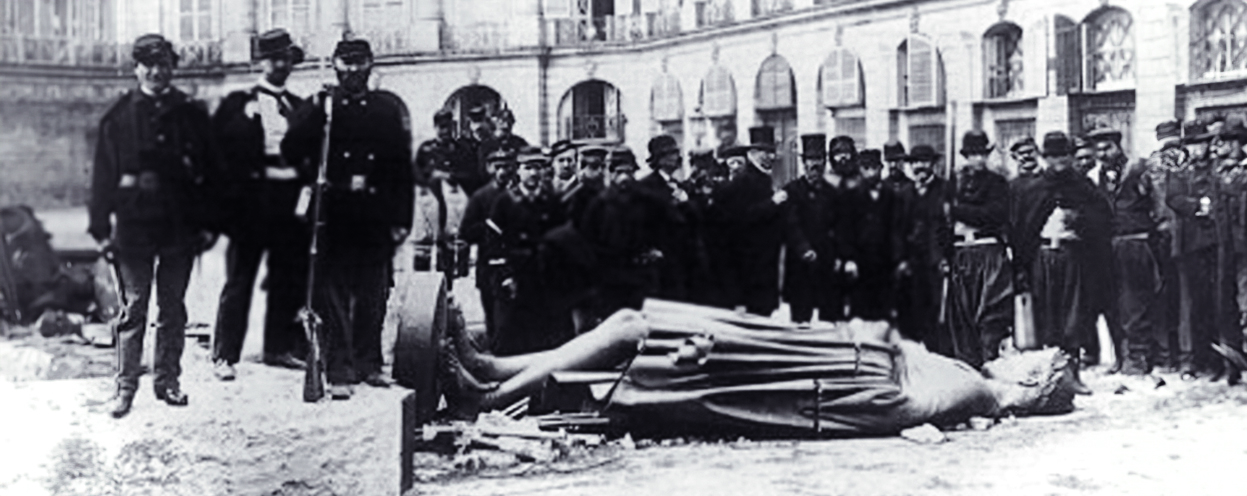Anti-Catholic Propaganda

One of the most frequently repeated propaganda techniques used against the Catholic Church through the ages was and is the attempt to morally compromise the Catholic clergy, especially those who choose to live by radical virtues and the counsel of the Gospel, taking vows of poverty, obedience, and chastity.
Since the times of the Reformation, Catholic religious orders have been prominent targets for anti-Catholic propagandists. Immediately after declaring himself “head of the Church in England” in 1536, Henry VIII (whose first decision as “head of the Church” was to enact his own divorce) proceeded to close monasteries in his kingdom and to pillage their goods (such as real estate and votive offerings contributed to them over the course of centuries) on a massive scale. This act of mass theft was accompanied by a massive propaganda program, the likes of which had never been seen in the history of modern Eur-ope, basing itself on the most vulgar lies. Bribed by the royal treasury, pamphleteers — carefully directed by Henry’s minion Thomas Cromwell — flooded Britain with a veritable ocean of brochures and tracts in which they “discovered” the immoral personal conduct of friars and nuns. They then started circulating rumors about thousands of small skeletons found by the royal functionaries in the cellars of the monasteries – macabre evidence of moral licentiousness being committed behind the monastic walls. This is how, according to Cromwell’s propagandists, the children conceived through immoral unions were buried.
Whom do we have to thank for the fall of the Roman Empire?
The Enlightenment added its own two cents worth (or shall we say an entire treasury) to the prejudices against the religious orders. In the eighteenth century, the Enlightenment elites blamed the religious orders for practically everything. For example, the British historian Edward Gibbon, author of the monumental work The Fall of the Roman Empire, blamed the monks for causing the fall of the Roman Empire and the moral decay of Roman civilization.
What a multitude of misfortunes — according to Gibbon — awaited the people entering the walls of the monasteries in the fourth century! In the aforementioned The Fall of the Roman Empire we read: “The unfortunate social outcasts were driven by a spirit of gloomy and intractable superstition. (…) Popu-lar monks, whose reputations were linked to the fame and successes of their orders, strenuously applied themselves to increasing the numbers of inmates. They sneaked into noble and affluent families employing hypocritical tricks of flattery and temptation, in order to assure themselves of the newly converted who could enhance the wealth and dignity of the clergy.”
The words highlighted in this passage show that Gibbon not only wrote a history of the fall of the Roman Empire, but incidentally occupied himself with anti–Catholic propaganda portraying the monasteries as prisons, and the monks as dark, limited, and cunning swindlers.
According to the Enlightenment historian, it was not a barbarian invasion in the epoch of the so-called nomadic peoples that ended the splendid Roman civilization. There were even worse barbarians (in his opinion) than Alaric the Goth or Attila the Hun who attacked its foundations: “all masculine virtues were persecuted under the servile and petty rule of the monks. If it were possible to measure the divide between the philosophical writings of Cicero and the holy legend of Theodoretus, between such personages as Katon and Simeon Stylites, we could adequately evaluate the memorable revo-lution which took place in the Roman Empire over the course of five hundred years.”
Propaganda, pornography, and anti-Catholicism
Numerous anti-Catholic novels appearing in the epoch of the Enlightenment employed additional “poetry,” as well. This type of literature often verged on pornography, and it was the greatest of the Enlightenment philosophers who occupied themselves with it. It should suffice to mention at this point Dennis Diderot, the co-author of the Enlightenment Encyclopedia and author of Jacques the Fatalist. In 1760, Diderot wrote the so-called philosophical novel entitled The Nun. The story line of this book is simple and suggestive (typical of propaganda): a young girl is locked behind the walls of a convent against her will. There she meets nuns who are either mentally unstable or displaying sexual deviations (lesbian). In the end, the girl manages to escape, but before she frees herself completely, she must still confront a certain Benedictine, who tried to rape her.
The underlying message of this “philosophical novel,” then, is clear: the monasteries are caverns of
moral decay. Besides, Diderot was of the opinion that the method accepted by Voltaire, for example, of fighting Catholicism by demonstrating the “non-historical” nature of the Gospels and ridiculing the clergy’s ignorance was a mistaken approach. Diderot believed it was much better to fight the Church by means of morally denigrating the clergy. The point he emphasized in one of his tracts was that the moral level of the clergy was not a high one. The “holier” a priest is, the more dangerous he is.
In the opinion of the phil-oso-pher, one cannot permit the image of the clergy – if not holy then struggling to overcome their faults and sins — to be perpetuated in the eyes of public opinion. It was necessary to work towards perpetuating a completely different image. As the author of Jacques the Fatalist wrote: “the fallen priest is helpless; his greed, appetite for splendors, intrigues, and bad habits were more destructive to religion than all the efforts of faithlessness.”
Hence, Karl Marx’s reminiscing about Diderot being one of his favorite authors comes as no surprise. Indeed, the analysis by the author of The Nun cited a moment ago was – and unfortunately remains – the current directive for authors of subsequent anti-Catholic propaganda campaigns.
It was no different during the ongoing “culture wars” of the nineteenth century. Extensive articles about Barbara Ubryk, the “miserable Carmelite of Cracow”, appeared almost simultaneously in the liberal German, French, and Italian press in 1869, as well as across the ocean. The liberal press of Europe and Amer-ica unleashed a subsequent wave of anti-Catholic hysteria by exploiting the story about the psychologically ill nun who, because of her affliction, was kept in her individual cell in the convent from 1848 to 1869.
The theme of the convent as a “prison for women” returned, and the religious life was defined as “a century of darkness and the committing of hidden atrocities [against women].” One of the liberal German titles incited its readers: “If only Barbara Ubryk were the only one of the miserable women secretly imprisoned! But she was lucky compared to thousands of other victims of convent life. It is rare to encounter a [monastery or] convent in which monks or nuns were not buried alive and cruelly murdered. Documents describing these atrocities can be found in all the national archives dealing with past [monasteries and] convents.”
The motive of sexual violence is also exploited, appearing, for instance, in the German press and anti-Catholic popular literature of the 1860s. Characters like menacing priors (“die Oberin”) are portrayed as sadistic transvestites (“die Mänin”) in the nineteenth century.
“The Contempt Industry” during the Paris Commune
During the Paris Commune (1871), when there was a massive closure of the churches and convents lo-cated in the French capital, the communards showed … prosthetic devices found in one of the convents being inspected as proof of “atrocities” and “torture” committed in the convents. It is difficult to offer better proof of the “efficacy” of the “we are discovering the dark secrets of the convents” propaganda conducted for many years.
It is nonetheless worthwhile considering for a moment the Paris Commune, which was recognized by Karl Marx as the prototype for the Communist Revolution. The communards declared from the very beginning “the separation of the Church from the state”, which effected the exclusion of the Church from schools, the confiscation of Church property, and the execution of priests, starting with Paris archbishop Georges Darboy. This anti-Catholic policy was accompanied by a systematic propaganda of humiliating and ridiculing the clergy, today called “the contempt industry.” For example, a common term used by the Paris Commune for the religious was “les ignorantins” (“the brothers of ignorance”) or “les ignorantines” (“the sisters of ignorance”). In the revolutionary clubs, which were the direct support network of the Paris Commune, there was a completely serious debate about postulates to send all the priests to French Guiana, where the tropical climate “would finish the deed.”
It often occurred that those clubs held their debates in confiscated churches. Among the representative authorities of the Commune there were also voices demanding the seizure of all Parisian churches by the communards. Henri Mortier, holding office in the Parisian revolutionary authority, conceived in May 1871 a vision of a future adaptation of churches for new “higher” purposes: “I would like therefore to see them open for debating atheism in them and, with the help of science, destroying the old superstitions and concepts that the Jesuit gang managed to foist onto simple minds.” From here, it’s not far to the Soviet “museums of atheism” organized in both Orthodox and Catholic churches.
Among the products of the anti-Catholic “contempt industry” implemented by the Paris Commune were their attempts, as mentioned above, to physically exterminate the clergy. This was merely a continuation of enduring themes in the anti-Catholic discourse. Whomever they failed to murder, they disgraced.
The interrogation of one of the Jesuits incarcerated by Raoul Rigault – the chief of police of the Paris Commune – provides a typical example in this regard. Rigault: “What is your occupation?” The Jesuit: “servant of God”. Rigault: “Where does your lord dwell?” The Jesuit: “Everywhere.” Rigault, addressing the court stenographer: “Please note: X, claiming to be the servant of some God who is engaged in vagrancy.”
The Paris Commune as the prototype of a national revolution thrilled Karl Marx and Friedrich Engels, and later Lenin, and the thrill stemmed not only from the communist environment. The French Masons were also quick to support the Commune. In a May 5, 1871 appeal directed “to brothers from France and from the entire world”, the Parisian Masons described the Commune as “the sword which was drawn in Paris only for the defense of humanity”; and “the point the brothers of Paris” are trying to make is “that justice should be translated from theory into practice.”
Anti-Catholicism and Antisemitism hand in hand
The belligerence of the anti-Catholic propagandists was so great that, at times, in order to achieve their goal (i.e. to denigrate Catholicism), they drew upon current antisemitic sentiments existing in society. The German National Socialists (Nazis) of the twentieth century would operate largely in the same way, declaring a bitter struggle “against the Jews” and “against the Romans.”
It is worth noting that a similar line of propaganda attack was used in the nineteenth century. In 1867, Gustave Tridon, who was aligned with the French radical left, wrote a treatise entitled On Jewish Molochism. The principal thesis of the book was as follows: “Semites are a shadow on the image of civilization, the evil genius of humanity. All of their gifts are curses. Combating the Semitic spirit – that is the task of the Indo–Arian race.” How then was the struggle against the “Semitic spirit” to play out? Tridon answered that it would be best to start from the determined rejection of the product of this spirit, that is the Holy Scripture (both the Old and New Testaments). According to him, the Old Testament was a load of “Jewish fairy tales,” Jehovah, who was nothing more than a local variation of Moloch, being the principal among them. According to Tridon, Jesus Christ was the same, so Christianity was also the religion of Moloch. The times of Moloch were the Middle Ages: “Human sacrifice, in the entire meaning of these words, took place in the Middle Ages. This is the revelation which should transform the history of this age to its foundations.”
70 years later, in the German Third Reich, Alfred Rosenberg — the official ideologue of Hitlerian Germany — would express a similar thesis in Myths of the Twentieth Century.






